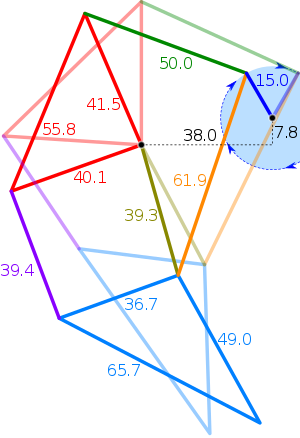Jansen's linkage
File:Theo Jansen 'reanimeert' een van zijn strandbeesten.webm
Jansen's linkage is a kinematic chain invented by the kinetic sculptor Theo Jansen since 1990. Jansen's linkage is designed to simulate a smooth walking motion. Jansen has used this mechanism in his Strandbeest creations, which are large, multi-legged walking sculptures that move with the help of wind power on beaches. The linkage system is a remarkable example of kinematics, the branch of mechanics that describes the motion of points, bodies (objects), and systems of bodies (groups of objects) without considering the forces that cause them to move.
Overview[edit | edit source]
Jansen's linkage consists of several rigid members connected by pivot joints forming a complex, yet elegantly simple, walking mechanism. The linkage is specifically engineered to mimic the gait of legged animals and is characterized by its smooth, natural motion. Unlike traditional wheel-based motion, Jansen's linkage offers the advantage of moving over soft or uneven terrain, making it particularly interesting for applications in robotics and kinetic art.
Design and Function[edit | edit source]
The design of Jansen's linkage involves a series of triangles and links that are proportioned according to specific mathematical ratios. These ratios are crucial for achieving the desired walking motion. The mechanism typically includes pairs of legs on either side of the structure, which move in a coordinated fashion to propel the sculpture forward.
Each leg in the linkage system is composed of several bars connected by pivoting joints. The movement of these legs is generated by a rotating axle that is often powered by wind, although some implementations use electric motors. The rotation of the axle causes the legs to move in a pattern that closely resembles the walking motion of an animal.
Applications[edit | edit source]
While Jansen's linkage was initially developed for artistic purposes, its potential applications extend far beyond the realm of kinetic sculpture. The principles underlying the linkage have implications for robotics, where the mechanism can be used to develop more efficient and adaptable walking robots. Additionally, the linkage finds applications in mechanical engineering and design, particularly in areas requiring stable movement over irregular terrain.
Impact and Legacy[edit | edit source]
The invention of Jansen's linkage has had a significant impact on the fields of kinetic art and mechanical design. Theo Jansen's Strandbeests have gained international recognition, showcasing the potential of combining art, engineering, and environmental consciousness. The linkage system has inspired engineers and artists alike to explore new ways of thinking about motion and design.
See Also[edit | edit source]
Search WikiMD
Ad.Tired of being Overweight? Try W8MD's physician weight loss program.
Semaglutide (Ozempic / Wegovy and Tirzepatide (Mounjaro / Zepbound) available.
Advertise on WikiMD
|
WikiMD's Wellness Encyclopedia |
| Let Food Be Thy Medicine Medicine Thy Food - Hippocrates |
Translate this page: - East Asian
中文,
日本,
한국어,
South Asian
हिन्दी,
தமிழ்,
తెలుగు,
Urdu,
ಕನ್ನಡ,
Southeast Asian
Indonesian,
Vietnamese,
Thai,
မြန်မာဘာသာ,
বাংলা
European
español,
Deutsch,
français,
Greek,
português do Brasil,
polski,
română,
русский,
Nederlands,
norsk,
svenska,
suomi,
Italian
Middle Eastern & African
عربى,
Turkish,
Persian,
Hebrew,
Afrikaans,
isiZulu,
Kiswahili,
Other
Bulgarian,
Hungarian,
Czech,
Swedish,
മലയാളം,
मराठी,
ਪੰਜਾਬੀ,
ગુજરાતી,
Portuguese,
Ukrainian
Medical Disclaimer: WikiMD is not a substitute for professional medical advice. The information on WikiMD is provided as an information resource only, may be incorrect, outdated or misleading, and is not to be used or relied on for any diagnostic or treatment purposes. Please consult your health care provider before making any healthcare decisions or for guidance about a specific medical condition. WikiMD expressly disclaims responsibility, and shall have no liability, for any damages, loss, injury, or liability whatsoever suffered as a result of your reliance on the information contained in this site. By visiting this site you agree to the foregoing terms and conditions, which may from time to time be changed or supplemented by WikiMD. If you do not agree to the foregoing terms and conditions, you should not enter or use this site. See full disclaimer.
Credits:Most images are courtesy of Wikimedia commons, and templates Wikipedia, licensed under CC BY SA or similar.
Contributors: Prab R. Tumpati, MD



